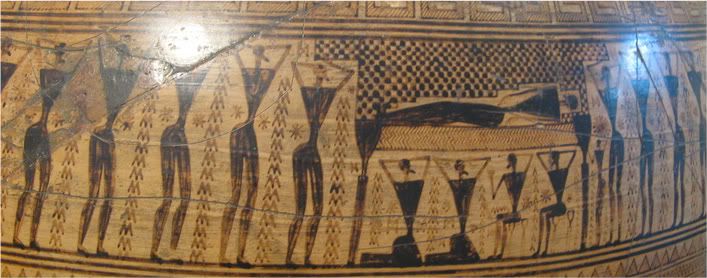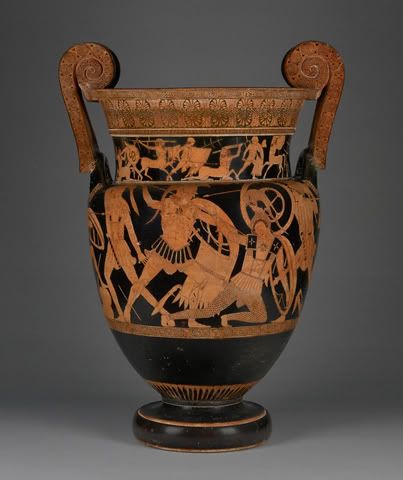Methodology
Cherry tries to balance between a comparative historical approach and while not generalizing the comparison so far that it yields no useful results. He argues that Aegean provides a situation within a small area in which there were multiple cycles of complex societies in which the early society completely collapsed before the next cycle (Cherry 18). He explains that it is unusual for scholars (or was in the mid-1980s) to do so, and "the lack of incentive is no doubt attributable to the feeling that there are simply too many real differences, both in general structure and particular detail, between the political systems of the Classical world and those of the Bronze Age for a unified analytical framework to be anything other than superficial" (Cherry 19). He balances against the "too much writing both about Greek Bronze Age states and about the later poleis has been bedevilled by the assumption that they are simply sui generis and thus cannot stand in comparison with other institutions" [3] (Cherry 24).
He has two aims: first, to crystalize the analysis around the central concept of the state in order to understand changes in the archeological record and second to distill a long history of analysis in different fields in order to place the 'polities of the Minoan and Mycenean worlds in the broader contests they demand" (Cherry 24).
Historical Analysis
According to Cherry, there are a number of different factors that are often included in the explanation for ancient state formation, including agriculture, the nature of the earlier settlements, etc but there are a large group of similar societies that did not develop into states (e.g. place-like cultures). Cherry's question, then, is what makes the Minoan settlements, and specifically Crete, develop unlike other areas with similar circumstances (Cherry 21-23).
The first major change is the shift from the subsistence basis of the economy in the Neolithic to the cultivation of the grape vine and the olive tree (Cherry 24) and the "secondary products revolution" using livestock for "milk, wool, riding. traction, and pack transport" (Cherry 25) rather than solely for meat. However, although this certainly boloster the economic base, it cannot be sufficient for the creation of a palatal society because many places experienced this "secondary products revolution" and did not become full civilizations (Cherry 26-27).
Another problem with the traditional model of understanding the rise of Minoan civilization is that scholars and archaeologists usually assume a slue period of growth over 2 millennia that lead to the emergence of palace culture, including a culture of "proto-palaces." However, according to Cherry, there is little evidence of this slow growth, especially because more recent excavations and analysis shows the "proto-palaces" to be small villages rather than single manors (Cherry 27-29). This points to a quicker development, but there is little evidence of this developmental phase (Cherry 33).
One of the unique things about the evidence of Minoan society is a lack of defensive walls a militaristic culture. This lead to the dominant "'consensus' model of palace origins, in which the palaces are seen as the focal points of activities contributing to the general welfare" (Cherry 33). However, as Cherry points out, "Rather than asking 'What services did Minoan rulers provide for society', perhaps the question should be inverted: 'In spite of the fact that their activities serve their own ends, how did the elite establish and maintain their control?' No ruler can hope to retain power without using the stick as well as the carrot" (Cherry 34). So if there was not a militarism of direct force, ther must have been a strong ideological basis for the rule, although I think cherry goes too far when he compares it to the Augustan ideological reforms (Cherry 35).
The final point that Cherry makes is that the location of Crete, with easy trade-routs to the established cultures in the east might have provided the necessary edge for the development of an organized and bureaucratic palatal society (Cherry 36) based more on wealth and diplomatic contacts than military might.
Endnotes
- Early on in the article, Cherry addresses the problem with the anachronism and problematic model connoted by the word "state" and explains it as such: " The state can be defined as a powerful, complex, permanently instituted, system of centralised political administration; it exercises sovereignty in carrying out basic political functions (e.g. maintaining territorial rights and internal order, or making and executing decisions regarding group action) and its authority in these matters is buttressed by sovereignty in the use of force within its jurisdiction. States are also societies with relatively complex and specialised administrative organisation, involving hierarchically ordered personnel who perform specialised administrative task and make decisions" (Cherry 23).
- Cherry, John F. "The Emergence of the State in the Prehistoric Aegean," The Cambridge Classical Jounral: Proceedings of the Cambridge Philological Society. No. 210 (New Series, No. 30). 1984. p18-28.
- While I found myself banging my head against the wall in classes listening to wind-bag history majors making absurd claims comparing Athenian metics to 19th century Eastern European emigrants and subsequently decided that all comparative historical claims were totally bogus for the Ancient World, I realized that Cherry has a point. Restricting comparisons by location and period, as well as critically evaluating the comparative frameworks, could provide useful information that might not arise from avoiding comparative methodology entirely.



















